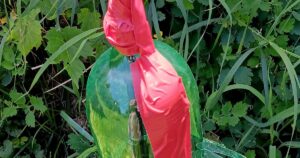
auto draft 1.png
Erosion
Definition: Erosion is the process by which soil, rock, or sediment is gradually removed and transported from one location to another by natural forces such as water, wind, ice, or gravity. It is a natural geomorphological phenomenon and a major environmental concern in agriculture, leading to soil loss, land degradation, and ecosystem disruption.
Description: Erosion occurs when soil particles are detached, entrained, and transported by erosive agents such as rainfall, surface runoff, wind, waves, or glaciers, resulting in the gradual wearing away of land surfaces and the redistribution of sediment across landscapes. Erosion processes can be accelerated by human activities such as deforestation, agriculture, construction, mining, and urbanization, leading to accelerated soil erosion rates and increased environmental impacts.
Fall off the barn roof and busted your keister? Life on the farm or ranch can be tough on the bum. Need a break? Laugh it off at FarmerCowboy.com, the #1 farm humor site. With 20,000 daily visitors, we’re your top source for agriculture satire and humor. Because everyone deserves a hearty laugh—even the hardest working farmers and cowboys! Join us and turn those long days into fun tales at FarmerCowboy.com.
Types of Erosion: Erosion can occur through various mechanisms and processes, including:
- Water Erosion: Water erosion is caused by the impact of rainfall, surface runoff, streamflow, or floodwaters on soil surfaces, leading to sheet erosion, rill erosion, gully erosion, and streambank erosion, depending on the intensity, duration, and velocity of water flow.
- Wind Erosion: Wind erosion occurs when soil particles are lifted, suspended, and transported by wind currents, resulting in deflation, abrasion, and deposition of soil particles, forming sand dunes, loess deposits, blowouts, or desert pavement.
- Glacier Erosion: Glacier erosion involves the movement of ice masses, glaciers, or ice sheets over land surfaces, scouring, plucking, and abrasively eroding bedrock, sediments, and soil materials, shaping valleys, fjords, cirques, and moraines.
- Coastal Erosion: Coastal erosion is driven by wave action, tidal currents, storm surges, and sea-level rise, eroding shorelines, beaches, cliffs, and dunes, causing coastal retreat, shoreline recession, and land loss in vulnerable coastal areas.
- Gravity Erosion: Gravity erosion includes mass wasting processes such as landslides, rockfalls, soil creep, slumping, and subsidence, triggered by gravitational forces, slope instability, seismic activity, or anthropogenic disturbances, resulting in slope failure and sediment movement.
Causes of Erosion: Erosion is caused by natural and human factors, including:
- Climate: Climatic factors such as rainfall intensity, frequency, distribution, seasonality, and erosivity, as well as wind speed, direction, duration, and fetch, influence erosion rates and patterns by affecting soil moisture, surface runoff, vegetation cover, and erosive forces.
- Topography: Terrain characteristics such as slope steepness, slope length, slope aspect, elevation, relief, and landform morphology influence erosion susceptibility, runoff generation, sediment transport, and sediment deposition processes on landscapes.
- Soil Properties: Soil properties such as texture, structure, porosity, permeability, compaction, organic matter content, aggregate stability, and soil moisture retention capacity affect erosion resistance, erodibility, and susceptibility to detachment, transport, and deposition by erosive agents.
- Vegetation Cover: Vegetative factors such as vegetation type, density, height, biomass, root depth, canopy cover, and land use practices influence erosion control, sediment trapping, soil stabilization, infiltration rates, and water retention on land surfaces.
- Land Management: Agricultural practices, land use changes, deforestation, overgrazing, tillage, irrigation, drainage, land clearing, mining, road construction, and urban development alter surface conditions, disrupt natural drainage patterns, and accelerate erosion rates on disturbed landscapes.
- Human Activities: Anthropogenic activities such as soil disturbance, land conversion, land degradation, soil compaction, soil sealing, surface sealing, pollution, deforestation, urbanization, and industrialization exacerbate erosion risks, soil losses, and environmental impacts on ecosystems.
Impacts of Erosion: Erosion has numerous environmental, economic, and social impacts, including:
- Soil Loss: Erosion leads to the loss of topsoil, organic matter, nutrients, and soil fertility, reducing agricultural productivity, crop yields, and food security, and exacerbating soil degradation, desertification, and land abandonment in vulnerable regions.
- Sedimentation: Erosion transports sediment, silt, and sedimentary particles downstream, depositing sediment in rivers, reservoirs, lakes, estuaries, wetlands, and coastal zones, leading to sedimentation, siltation, and habitat degradation, and impairing water quality, aquatic ecosystems, and navigation channels.
- Land Degradation: Erosion contributes to land degradation, soil erosion, and soil desertification, compromising ecosystem services, biodiversity, carbon sequestration, and watershed functions, and degrading natural habitats, cultural landscapes, and archaeological sites.
- Water Pollution: Erosion transports pollutants, nutrients, pesticides, herbicides, heavy metals, pathogens, and sediment-bound contaminants from agricultural fields, urban areas, construction sites, and industrial facilities into water bodies, causing water pollution, eutrophication, and aquatic ecosystem degradation.
- Infrastructure Damage: Erosion undermines infrastructure stability, damages roads, bridges, culverts, pipelines, buildings, and utilities, increases flood risks, property losses, and insurance claims, and poses safety hazards to human communities, transportation networks, and critical facilities.
- Socio-Economic Costs: Erosion imposes socio-economic costs, including lost agricultural production, reduced water availability, increased flood damages, degraded ecosystems, diminished recreational opportunities, impaired cultural heritage, and increased poverty, displacement, and social vulnerability in affected regions.
Erosion Control Measures: Managing erosion requires implementing various erosion control measures and best management practices (BMPs), including:
- Soil Conservation: Adopting soil conservation practices such as contour plowing, terracing, strip cropping, buffer strips, conservation tillage, cover cropping, and agroforestry to reduce soil erosion, runoff velocity, and sediment losses from agricultural fields.
- Vegetative Stabilization: Establishing vegetative cover, grassed waterways, riparian buffers, windbreaks, shelterbelts, hedgerows, or vegetative barriers to stabilize soil, prevent erosion, intercept runoff, trap sediment, and enhance biodiversity in vulnerable areas.
- Erosion Control Structures: Constructing erosion control structures such as retaining walls, gabions, check dams, silt fences, sediment traps, erosion blankets, erosion control mats, or bioengineering structures to mitigate erosion, channelize runoff, and protect vulnerable slopes, banks, or shorelines.
- Land Management Practices: Implementing sustainable land management practices, land-use planning, zoning regulations, erosion control ordinances, soil conservation programs, payment for ecosystem services (PES) schemes, and agro-environmental subsidies to promote responsible land stewardship and prevent erosion.
- Soil Stabilization: Applying soil stabilization techniques such as soil amendments, soil binders, soil bioengineering, revegetation, soil reinforcement, soil compaction, or erosion control mulches to stabilize soil surfaces, prevent erosion, and restore vegetation cover on disturbed sites.
- Sedimentation Control: Installing sedimentation basins, settling ponds, sediment traps, sediment barriers, erosion control dams, or sediment retention structures to capture, detain, and settle sediment-laden runoff, reducing sedimentation, turbidity, and pollutant loads in receiving waters.
- Water Management: Implementing water management practices such as water harvesting, irrigation scheduling, drainage maintenance, stormwater management, floodplain restoration, wetland creation, and riverbank stabilization to regulate water flows, reduce erosion, and enhance water resilience in watersheds.
- Education and Outreach: Providing education, training, technical assistance, and outreach programs to farmers, landowners, communities, and stakeholders on erosion prevention, soil conservation practices, erosion control techniques, and sustainable land management strategies.
Conclusion: Erosion is a widespread environmental issue that poses significant challenges to soil conservation, land management, and ecosystem sustainability. By implementing erosion control measures, adopting sustainable land management practices, and promoting stewardship and resilience, communities can mitigate erosion impacts, protect natural resources, and preserve landscapes for future generations.
References:
- Montgomery, D. R. (2007). Soil erosion and agricultural sustainability. Proceedings of the National Academy of Sciences, 104(33), 13268-13272.
- Lal, R. (2001). Soil degradation by erosion. Land Degradation & Development, 12(6), 519-539.
- Boardman, J., & Favis-Mortlock, D. (Eds.). (2000). Soil erosion in the European Union: Changing perspectives. John Wiley & Sons.
Originally posted 2019-08-05 15:10:53.
Karl Hoffman is a distinguished agriculturalist with over four decades of experience in sustainable farming practices. He holds a Ph.D. in Agronomy from Cornell University and has made significant contributions as a professor at Iowa State University. Hoffman’s groundbreaking research on integrated pest management and soil health has revolutionized modern agriculture. As a respected farm journalist, his column “Field Notes with Karl Hoffman” and his blog “The Modern Farmer” provide insightful, practical advice to a global audience. Hoffman’s work with the USDA and the United Nations FAO has enhanced food security worldwide. His awards include the USDA’s Distinguished Service Award and the World Food Prize, reflecting his profound impact on agriculture and sustainability.



